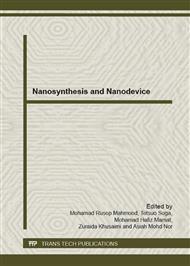[1]
J. Jitputti, Y. Suzuki, S. Yoshikawa, Synthesis of TiO2 nanowires and their photocatalytic activity for hydrogen evolution, Catal. Commun. 9 (2008) 1265–1271.
DOI: 10.1016/j.catcom.2007.11.016
Google Scholar
[2]
Y. Lin, Photocatalytic activity of TiO2 nanowire arrays, Mater. Lett. 62 (2008) 246-248.
Google Scholar
[3]
K. Asagoe, Y. Suzuki, S. Ngamsinlapasathian, S. Yoshikawa, TiO2- Anatase Nanowire Dispersed Composite Electrode for Dye-Sensitized Solar Cells, J. Phys.: Conf. Series 61 (2007) 1112-1116.
DOI: 10.1088/1742-6596/61/1/220
Google Scholar
[4]
X. Su, Q. Wu, X. Zhan, J. Wu, S. Wei, Z. Guo, Advanced titania nanostructures and composites for lithium ion battery, J. Mater. Sci. 47 (2012) 2519–2534.
DOI: 10.1007/s10853-011-5974-x
Google Scholar
[5]
C. Cao, C. Hu, X. Wang, S. Wang, Y. Tian, H. Zhang, UV sensor based on TiO2 nanorod arrays on FTO thin film, Sens. Actuators B 156 (2011) 114-119.
DOI: 10.1016/j.snb.2011.03.080
Google Scholar
[6]
R. J. Wu, Y. L. Sun, C. C. Lin, H. W. Chen, M. Chavali, Composite of TiO2 Nanowires and Nafion as humidity sensor material, Sens. Actuators B 115 (2006) 198-204.
DOI: 10.1016/j.snb.2005.09.001
Google Scholar
[7]
J. Watthanaarun, V. Pavarajarn, P. Supaphol, Titanium (IV) oxide nanofibers by combined sol–gel and electrospinning techniques: preliminary report on effects of preparation conditions and secondary metal dopant, Sci. Tech. Adv. Mater. 6 (2005).
DOI: 10.1016/j.stam.2005.02.002
Google Scholar
[8]
J. Shi, X. Wang, Growth of Rutile Titanium Dioxide Nanowires by Pulsed Chemical Vapor Deposition, Cryst. Growth 11 (2011) 949–954.
DOI: 10.1021/cg200140k
Google Scholar
[9]
R. Yoshida, Y. Suzuki, S. Yoshikawa, Synthesis of TiO2(B) nanowires and TiO2 anatase nanowires by hydrothermal and post-heat treatments, J. Solid State Chem. 178 (2005) 2179-2185.
DOI: 10.1016/j.jssc.2005.04.025
Google Scholar
[10]
R. A. Zarate, S. Fuentes, A. L. Cabrera, V. M. Fuenzalida, Structural characterization of single crystals of sodium titanate nanowires prepared by hydrothermal process, J. Cryst. Growth 310 (2008) 3630-3637.
DOI: 10.1016/j.jcrysgro.2008.05.020
Google Scholar
[11]
J. Xie, X. Wang, Y. Zhou, Understanding Formation Mechanism of Titanate Nanowires through Hydrothermal Treatment of Various Ti-Containing Precursors in Basic Solutions, J. Mater. Sci. Technol. 28 (2012) 488-494.
DOI: 10.1016/s1005-0302(12)60087-5
Google Scholar
[12]
T. Kasuga, M. Hiramatsu, A. Hoson, T. Sekino, K. Niihara, Formation of Titanium Oxide Nanotube, Langmuir 14 (1998) 3160-3163.
DOI: 10.1021/la9713816
Google Scholar
[13]
D. V. Bavykin, J. M. Friedrich, F. C. Walsh, Protonated Titanates and TiO2 Nanostructured Materials: Synthesis, Properties, and Applications, Adv. Mater. 18 (2006) 2807-2824.
DOI: 10.1002/adma.200502696
Google Scholar
[14]
B. Poudel, W. Z. Wang, C. Dames, J. Y. Huang, S. Kunwar, D. Z. Wang, D. Banerjee, G. Chen, Z. F. Ren, Formation of crystallized titania nanotubes and their transformation into nanowires, Nanotechnology 16 (2005) 1935–(1940).
DOI: 10.1088/0957-4484/16/9/086
Google Scholar
[15]
R. A. Zarate, S. Fuentes, J. P. wiff, V. M. Fuenzalida, A. L. Cabrera, Chemical composition and phase identification of sodium titanate nanostructures grown from titania by hydrothermal processing. J. Phys. Chem. Solids 68 (2007) 628-637.
DOI: 10.1016/j.jpcs.2007.02.011
Google Scholar
[16]
S. P. S. Porto, P. A. Fleury, T. C. Damen, Raman Spectra of TiO2, MgF2, ZnF2, FeF2, and MnF2, Phys. Rev. 154 (1967) 522-526.
Google Scholar
[17]
T. Ohsaka, F. Izumi, Y. Fujiki, Raman spectrum of anatase, TiO2, J. Raman Spectrosc. 7 (1978) 321-324.
DOI: 10.1002/jrs.1250070606
Google Scholar


